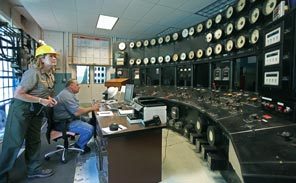Originally published Saturday, September 17, 2011 at 7:02 PM
Dams' removal: a long goodbye for powerhouses that transformed a region
An era is coming to an end as the once-mighty Elwha and Glines Canyon dams are taken down.
Seattle Times staff reporter

THE DAMS
Story: An unprecedented restoration effort
THE HISTORY
Timeline: An Elwha River chronology
Video: Building dams, powering the economy
THE SALMON
Story: Will giant chinook salmon return?
Graphic: The five species of Elwha salmon
THE TRIBE
Story: The ancestors' prayers answered
Video: A talk with elder Adeline Smith
REVEGETATION
Story: Restoring a healthy watershed
THE SEDIMENT
Story: Biggest-ever sediment release
Graphic: Picturing 24 million cubic yards
CHAT REWIND
Behind the scenes of the Elwha special report
PROJECT HOME
![]()
After rumbling and roaring for nearly a century, these powerhouses are just hulks in the way now. But for decades the Elwha and Glines Canyon dams powered the economic growth of Port Angeles and the Olympic Peninsula.
When Canadian entrepreneur Thomas Aldwell started construction of 108-foot-tall Elwha Dam in September 1910 in a narrow gorge just five miles from the river mouth, the region rooted for him:
"Far down in the canyon cut through the rock by the Elwha in its centuries long course to the seas appeared the evidence of man's ingenuity in harnessing nature," a reporter for The Seattle Times wrote May 1, 1911. "Uprearing high in the air, a gigantic derrick with mathematical precision lowered slings of earth to the men at work on the coffer dam more than 100 feet below, while the roar of the machinery vied with that of the river. The ... Elwha is now under control."
The dam began generating power in 1914, lighting towns all over the peninsula, and sending power as far as the naval shipyard in Bremerton and Fort Worden in Port Townsend. Glines Canyon Dam was built eight miles upriver to meet increasing demand for electricity, and began operation in 1927. Together, they powered the sawmills and pulp mills that grew the economy of Port Angeles and the Olympic Peninsula.
Both dams were built during a grand industrial age in America, when mammoth machinery was made of brass, glass and steel, all of it manufactured right here at home and built to last. And last they did: Both dams produced electricity and still retained much of their original instrumentation to the end — though some of it, such as the hand-cranked telephone in an oak phone booth at Glines Canyon — had become merely decorative. But the black slate control panel of Elwha Dam was still in use to the last minute of shutdown June 1, supported by a row of Doric steel columns.
Two of the turbines at Elwha Dam were the oldest of their kind on the West Coast, spinning reliably to the last in the 60-foot-high powerhouse, lit by floor-to-ceiling windows. But it was always Glines Canyon Dam that was the looker of the two, a 210-foot-tall concrete arch spanning a tight rock canyon.
The dams' powerhouses hummed and vibrated, run by operators who knew by feel and experience when the machinery was running in its sweet spot — and when something was amiss. Adjusting the stream flow through the dam's intakes to throttle generation up or down, operators like Billy "Clutch" Cargo, of Port Angeles, literally ran the river.
"Have you ever been a nanny?" Cargo asked, running Elwha Dam one morning not long before it was shut down. "When you sit here all day or night, it starts to become who you are. The solitude, the river, you can turn out the lights during the graveyard shift and feel that thrum at 60 cycles, and feel the whole place breathing and vibrating. It's alive."
Keeping the generators going day and night year-round in mountain weather took the work of men like Bob Williams of Port Angeles, who for 40 years was part of a two-man maintenance crew taking care of both dams. Hydraulic mechanic, lineman, logger, whatever was needed, he did it.
Back in the 1950s, Williams kept about 30 miles of transmission line cleared of fallen trees with a hand saw — or misery whip, as he called it — and cleaned carbon off the dams' generators by hand with a rag. "That was a nasty job," Williams said. "You get in there with rags and solvent and start mopping." Back in the day, he worked without even earplugs, despite the generators' 90-decibel roar. "You just sit there getting drilled in both ears."
He knew the dark, cold parts of the canyons the dams plugged, where the sun doesn't reach until May; the wind that came cutting off the lakes impounded by the dams. And he remembered the 1962 Columbus Day storm when the wind blew so hard up the Elwha Valley he saw a goose, trying to fly, pushed backward. "Don't know whatever happened to that goose."
The dams always were controversial.
Elwha Dam leaked from the start, and on Halloween night 1912, the dam blew out at the bottom, leaving a 90-foot hole in the foundation. The entire reservoir barreled through the gaping hole in an hour and a half, carrying away steel and concrete, overwhelming the powerhouse, and sweeping away a bridge. The Olympic Leader reported on Nov. 1, 1912, that a nearly 30-foot-high torrent ripped downriver, and "great numbers of salmon and trout were strewn over the fields and through the woods." Amazingly, no one was killed. Aldwell refinanced the crippled project and rebuilt it.
Elwha Dam was built without fish passage — illegal, even back then. But Aldwell finessed a deal with state fisheries officials, who let him build a hatchery instead of a fish ladder. Aldwell never turned over the deed to the land for the hatchery, as promised. The hatchery was abandoned by the state in 1922, when it failed to produce returning adult fish.
Aldwell sold his interest in Elwha Dam in 1919 and bailed out of the dam-building business to focus on industrial and real-estate development. It fell to Crown Zellerbach Corp., one of several subsequent owners of the dams over the years, to seek a license for Elwha — built before a license was required — and to relicense Glines Canyon Dam with the Federal Energy Regulatory Commission.
During the proceedings, the Lower Elwha Klallam Tribe in 1986 intervened and pushed for removal of both dams. Environmental groups joined in. Shawn Cantrell, formerly of Friends of the Earth, one of the first environmental organizations to back taking down the dams, remembers how far-fetched the notion of dam removal seemed at the time. "It was, 'it's a pretty extreme issue, for wackos, everyone will think we are crazy.' "
It still seemed that way to some, all the way up to the end, even though the power produced by the dams was easily replaced by the Bonneville power grid. But Noreen Frink, Thomas Aldwell's granddaughter, was philosophical when she was interviewed at her Seattle home a few months before dam removal started. Proud as she is of her grandfather, she also believed the dams' era had passed.
"I would like to see the dams come down," Frink said, "and the fish come up."
















